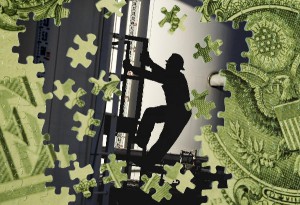
The productivity of U.S. workers unexpectedly fell in the second quarter, indicating companies may redouble efforts to contain costs as the recovery unfolds.
The figures show the world’s largest economy lost momentum heading into the second year of the recovery, one reason why companies are holding the line on employment and pay. Flagging growth and a slow jobs recovery have fueled investor expectations that Federal Reserve policy makers will announce efforts to spur the economy after meeting today.
“Slower growth in output will prompt companies to continue to focus on aggressive approaches to cost cutting,” said Joshua Shapiro, chief U.S. economist at Maria Fiorini Ramirez Inc., a New York forecasting firm. “This will heighten obstacles to a convincing labor-market recovery.”
Stock-index futures held earlier losses after the report. Futures on the Standard & Poor’s 500 Index dropped 0.9 percent to 1,115.4 at 9:08 a.m. in New York. The 10-year Treasury note rose, pushing down the yield to 2.82 percent from 2.83 percent late yesterday.
The Labor Department revised the first-quarter gain in efficiency to a 3.9 percent pace from 2.8 percent.
Labor Costs
The increase in unit labor costs, which are adjusted for efficiency gains, was the first gain in a year and followed a 3.7 drop in the first three months of the year that was larger than previously estimated. They were projected to rise at a 1.5 percent pace, according to the survey median.
The Labor Department today released revisions to the productivity report going back to 2007, reflecting the annual revisions to gross domestic product issued last month.
Hours worked last quarter increased at a 3.6 percent pace. Output rose at a 2.6 percent rate.
‘Unusually Uncertain’
Fed Chairman Ben S. Bernanke last month said the outlook for growth was “unusually uncertain,” and signaled that signs of deeper economic weakness would be needed to justify more stimulus. On Aug. 2 Bernanke said rising wages will probably spur household spending in the next few quarters.
The policy makers’ decision is scheduled to be released around 2:15 p.m.
Stocks and Treasury securities have climbed on speculation the Fed will act to spur growth. The S&P 500 rose 1.8 percent last week and the yield on the two-year note touched a record- low 0.4977 percent on Aug. 6.
Productivity increased 3.9 percent in the year ended June. It had increased 6.3 percent in the first quarter compared with a year earlier.
Among manufacturers, productivity increased at a 4.5 percent pace as output climbed faster than hours worked. Labor costs at factories dropped at a 6.1 percent pace from the previous three months.
Slower Growth
Economic growth has slowed since the first quarter, with the economy expanding at a 2.4 percent annual rate from April through June following gains of 3.7 percent the first three months of the year and 5 percent at the end of 2009.
Delta Air Lines Inc. is among companies looking to take on more staff. The world’s largest carrier plans to hire 1,000 workers at its 25 biggest U.S. airports to help with planes that are flying with near-record percentages of seats filled and cope with weather disruptions, Chief Executive Officer Richard Anderson said last month.
A Labor Department last week showed private companies added 71,000 jobs in July, fewer than the median forecast of economists surveyed.
The earlier surge in efficiency, by helping companies produce more with fewer workers, may be behind the reluctance to hire, Stanford University economist Robert Hall said last week. Increased business spending on new equipment helped increase productivity, explaining how economic output has risen while jobs have been stagnant, said Hall, who heads the National Bureau of Economic Research’s group charged with determining turning points in the economy.
General Dynamics Corp. is among companies still looking to cut expenses by streamlining work. The maker of Abrams tanks and Gulfstream business jets on July 28 posted second-quarter profit that rose 4.9 percent and raised its full-year earnings forecast.
“We continue to increase efficiency, improve productivity and drive cost out of our processes,” Chief Executive Officer Jay Johnson said in a statement.